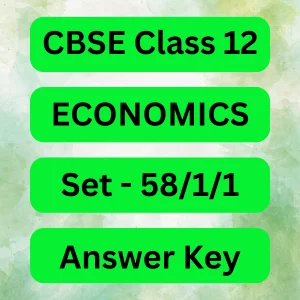Hello students, CBSE Class 12 Economics paper was held on 18.03.2024. We are here providing you economics answer key of Set 58/1/1. The answers also follow brief explanation which will help you understand the answer. You can download free pdf by clicking the picture below.
Table of Content
ToggleSection-A
Macro Economics
Q.1 Read the following statements carefully:
Statement 1: If in an economy the level of income increases (∆Y), it will always proportionately increase the level of consumption (∆C).
Statement 2: Marginal Propensity to Consume (MPC) and Marginal Propensity to Save (MPS) are always equal to each other.
In the light of the given statements, choose the correct alternative from the following:
(A) Statement 1 is true and Statement 2 is false.
(B) Statement 1 is false and Statement 2 is true.
(C) Both Statements 1 and 2 are true.
(D) Both Statements 1 and 2 are false.
Answer: (D) Both Statements 1 and 2 are false.
Brief Explanation: As per Psychological Law of Consumption, increase in consumption is normally less than increase in income. MPC and MPS can or cannot be equal to each other. They can be equal to each other only in one case – When out of additional income, half income is consumed and half is saved. Then MPC = 0.5 and MPS =0.5.
Q.2 Identify the correct equation from the following:
(A) GDPMP = NNPFC + Depreciation
(B) NDPFC = NNPFC + Net Indirect Taxes
(C) GNPMP = GDPMP + Net Factor Income from Abroad
(D) NNPFC = NDPMP + Depreciation
Answer: (C) GNPMP = GDPMP + Net Factor Income from Abroad
Brief Explanation: Conversion Rules are:
- National = Domestic + Net Factor Income from Abroad (NFIA)
Domestic = National – NFIA
- Gross = Net + Depreciation/Consumption of Fixed Capital
Net = Gross – Depreciation/Consumption of Fixed Capital
- Market Price = Factor Cost + Net Indirect Taxes (Indirect Taxes – Subsidies)
Factor Cost = Market Price – Net Indirect Taxes (Indirect Taxes – Subsidies)
Q.3 Read the following statements – Assertion (A) and Reason (R). Choose the correct alternative given below:
Assertion (A): Full employment situation refers to absence of involuntary unemployment.
Reason (R): Under full employment situation, all the willing and able bodied people get employment at the prevailing wage rate.
Alternatives:
(A) Both Assertion (A) and Reason (R) are true and Reason (R) is the correct explanation of Assertion (A).
(B) Both Assertion (A) and Reason (R) are true, but Reason (R) is not the correct explanation of Assertion (A).
(C) Assertion (A) is true, but Reason (R) is false.
(D) Assertion (A) is false, but Reason (R) is true.
Answer: (A) Both Assertion (A) and Reason (R) are true and Reason (R) is the correct explanation of Assertion (A).
Brief Explanation: Involuntary Unemployment refers to a situation where some able bodied persons are not able to get employment at prevailing or current wage rates. Since Full Employment is a situation where all able bodied persons get work who want to work on Prevailing (Current) wage rate, it implies zero involuntary unemployment or absence of involuntary unemployment
Q.4 “As per the National Stock Exchange (NSE) data, dated 9th June, 2023, there was a net selling off worth ₹ 309 crore by Foreign Institutional Investors (FIIs) over the period of one month i.e., 9th May, 2023 – 9th June, 2023.”
The above mentioned transactions will be recorded on________side of__________ account of Balance of Payments of India. (Choose the correct alternative to fill in the blanks)
(A) Debit, Current (B) Credit, Capital
(C) Credit, Current (D) Debit, Capital
Answer: (D) Debit, Capital
Brief Explanation: Since selling off by FIIs affects assets of India, it will be recorded under Capital Account. Moreover, as it will lead to outflow of money from India, such transactions will be entered on Debit Side.
Q.5 Identify the incorrect feature(s) of money supply (M1) from the following:
(i) It is measured at a point of time.
(ii) It does not include stock of money held by the government.
(iii) It is always the currency in the hands of the Central Bank of a nation.
Alternatives:
(A) (i) and (ii) (B) (ii) and (iii)
(C) (ii) only (D) (iii) only
Answer: (D) (iii) only
Brief Explanation: Money supply refers to the stock of money at a point of time. Own stock of money held by suppliers of money i.e Government of India, Reserve Bank of India and Commercial Banks is not counted in Money Supply.
Q.6 Total consumption expenditure by households under Keynesian Economics is a combination of____ and_______ . (Choose the correct alternative to fill in the blanks)
(A) Autonomous Consumption, Autonomous Investments
(B) Autonomous Investments, Induced Consumption
(C) Induced Investments, Autonomous Investments
(D) Autonomous Consumption, Induced Consumption
Answer: (D) Autonomous Consumption, Induced Consumption.
Brief Explanation: Consumption Function in Keynesian Economics is:
C = C̅ + b Y
Where C̅ is Autonomous Consumption (Consumption at 0 income and remains constant when income changes), b is Marginal Propensity to Consume (part of additional income that is consumed), Y is Income and bY is Induced Consumption (consumption which increases with increase in Income).
Q.7 Find the missing figures and choose the correct alternative:

Alternatives:
(A) 1000, 800, 20000, 25000
(B) 5000, 3200, 25000, 20000
(C) 1000, 3200, 25000, 20000
(D) 1000, 800, 20000, 25000
Answer: (C) 1000, 3200, 25000, 20000
Brief Explanation:
Money Multiplier (K) = 1/RR = 1/20% = 5
Answer for (i)
20% of 5000 = 1000
Answer for (ii)
80% of 4000 = 3200
Answer for (iii)
Total Deposit = Initial Deposit x K
= 5000 x 5 = 25000
Answer for (iv)
80% of 25000 = 20000
Q.8 Surplus in Balance of Payments (BOP) refers to the excess of .
(Choose the correct alternative to fill in the blank)
(A) Autonomous payments over Autonomous receipts
(B) Current Account payments over Autonomous receipts
(C) Capital Account receipts over Capital Account payments
(D) Autonomous receipts over Autonomous payments
Answer: (D) Autonomous receipts over Autonomous payments
Brief Explanation: Imbalance (surplus or deficit) in Balance of Payment (BoP) is caused by Autonomous Transactions which include both capital and current account transactions. So, surplus in BoP implies Autonomous Receipts being more than the Autonomous Payments.
In contrast to Autonomous Transactions, Accommodating Transactions like movement in Official Reserve Account, are used to correct imbalance in BoP.
Q.9 Suppose for a hypothetical economy:
C = 100 + 0·75Y (where C = Consumption and Y = Income) I0 = 400 (I0 = Autonomous Investment)
Value of Investment Multiplier (K) would be .
(Choose the correct alternative to fill in the blank)
(A) 5 (B) 4 (C) 6 (D) 3
Answer: (B) 4
Brief Explanation: In Consumption Function of the question, b or MPC = 0.75
So, K = 1/1-MPC = 1/1-0.75 = 1/0.25 = 4
Value of K can also be obtained from investment by following formula:
K = ∆Y/∆I.
However, ∆Y is neither given nor it can be obtained from the given set of data in the question.
Q.10 Suppose, the Balance of Trade of an imaginary economy shows a favourable balance of ₹ 500 crore. The values of merchandise exports are ₹ 1200 crore and transfer payments are ₹400 crore. The value of merchandise imports would be ₹________crore.
(Choose the correct alternative to fill in the blank)
(A) 1700
(B) 750
(C) 700
(D) 900
Answer: (C) 700
Brief Explanation: Balance of Trade include trade is goods/Merchandise only not transfer payments. Hence,
Balance of Trade = Export of Merchandise – Import of Merchandise (M)
500 = 1200–M
M = 1200–500
= 700
Section-B
Indian Economic Development
Q.18 Read the following statements- Assertion (A) and Reason (R). Choose the correct alternative given below:
Assertion (A): The excessive regulation of permit license raj prevented certain private firms from becoming fairly competitive.
Reason (R): Private sector wasted huge amounts in obtaining licenses rather than on improving the product quality and international competitiveness.
Alternatives:
(A) Both Assertion (A) and Reason (R) are true and Reason (R) is the correct explanation of Assertion (A).
(B) Both Assertion (A) and Reason (R) are true, but Reason (R) is not the correct explanation of Assertion (A).
(C) Assertion (A) is true, but Reason (R) is false.
(D) Assertion (A) is false, but Reason (R) is true.
Answer: (A) Both Assertion (A) and Reason (R) are true and Reason (R) is the correct explanation of Assertion (A).
Brief Explanation: Before 1991-reforms, private firms had to spend huge amounts to take permits and licenses, especially due to corruption. This would divert their funds which could have otherwise been used for increasing quantity and quality of their production. This made them less competitive.
Q.19 In the decade of the 1970s, Pakistan nationalized its________industries.
(Choose the correct alternative to fill in the blank)
(A) Medical infrastructure
(B) Consumer goods
(C) Capital goods
(D) Foreign trade
Answer: (C) Capital goods
Brief Explanation: Pakistan, like India, adopted Mixed Economic System with more focus on development of public sector. So, Pakistan nationalized Capital Goods Industries during 1970s.
Q.20 Read the following statements carefully:
Statement 1: Under the colonial rule, basic infrastructure (like railways, post and telegraph etc.) was developed.
Statement 2: The real motive behind the infrastructural development in India was to strengthen the British interests.
In the light of the given statements, choose the correct alternative from the following:
(A) Statement 1 is true and Statement 2 is false.
(B) Statement 1 is false and Statement 2 is true.
(C) Both Statements 1 and 2 are true.
(D) Both Statements 1 and 2 are false.
Answer: (C) Both Statements 1 and 2 are true.
Brief Explanation: It is true that whatever development work was done by the Colonial Government, it was always for British interests. However, India also got some benefits unintendedly. British Colonial Government developed Railways, post, telegraph, modern judicial system, modern education system etc, all for British interests primarily.
Q.21 Identify which of the following alternatives indicate the incorrect components combination of Agriculture Marketing System:
(A) Assembling, Storage, Processing, Packaging
(B) Production, Assembling, Processing, Grading
(C) Assembling, Processing, Packaging, Transportation
(D) Processing, Packaging, Grading, Distribution
Answer: (B) Production, Assembling, Processing, Grading
Brief Explanation: Agriculture Marketing starts from assembling of the produce till it reaches to the final consumer by process of distribution & selling. It does not include production & harvesting of crops.
Q.22 Read the following statements- Assertion (A) and Reason (R). Choose the correct alternative given below:
Assertion (A): World Trade Organization (WTO) is expected to establish the rule-based trading regime, to avoid unilaterally placed arbitrary restrictions by member nations.
Reason (R): It is imperative to enlarge world production and ensure optimum utilization of world resources along with environmental protection.
Alternatives:
(A) Both Assertion (A) and Reason (R) are true and Reason (R) is the correct explanation of Assertion (A).
(B) Both Assertion (A) and Reason (R) are true, but Reason (R) is not the correct explanation of Assertion (A).
(C) Assertion (A) is true, but Reason (R) is false.
(D) Assertion (A) is false, but Reason (R) is true.
Answer: (A) Both Assertion (A) and Reason (R) are true and Reason (R) is the correct explanation of Assertion (A).
Brief Explanation: WTO formulates rules of international trades and monitor that they are being followed by the member countries without putting unnecessary restrictions on international trade. These rules are targeted to optimally utilize world resources, while taking care of environmental concerns, in order to maximum production.
Q.23 Read the following statements- Assertion (A) and Reason (R). Choose the correct alternative given below:
Assertion (A): China has used the market mechanism to create additional social and economic opportunities for its citizens.
Reason (R): Social infrastructure creation by the government has brought positive results in human development indicators in China.
Alternatives:
(A) Both Assertion (A) and Reason (R) are true and Reason (R) is the correct explanation of Assertion (A).
(B) Both Assertion (A) and Reason (R) are true, but Reason (R) is not the correct explanation of Assertion (A).
(C) Assertion (A) is true, but Reason (R) is false.
(D) Assertion (A) is false, but Reason (R) is true.
Answer: (B) Both Assertion (A) and Reason (R) are true, but Reason (R) is not the correct explanation of Assertion (A).
Brief Explanation: They are indirectly related not directly. Social Infrastructure is result of market oriented reforms initiated in 1978 while improvement in human development indicators is result of development of social infrastructure.
As such, they are related but Reason is not the exact cause of Assertion.
Q.24 Identify from the following alternatives the incorrect objectives of regulated agriculture market:
(i) To make the marketing system efficient and effective for farmers to get best price of their products.
(ii) To discourage improvement of marketing infrastructure for farmers.
(iii) To prevent exploitation of farmers.
(iv) To discourage farmers from improving quality and quantity of their produce.
Alternatives:
(A) (i) and (ii)
(B) (i) and (iii)
(C) (iii) and (iv)
(D) (ii) and (iv)
Answer: (D) (ii) and (iv)
Brief Explanation: Regulated Agriculture Markets promote positive improvements which are beneficial for farmers. In the above question, statements like discouraging improvement of marketing infrastructure and farmers from improving quality and quantity of their produce are negative for farmers. So, they are wrong.
Q.25 Economic reforms were introduced in India and Pakistan in the years______ and_______ respectively. (Choose the correct alternative to fill in the blanks)
(A) 1988, 1978
(B) 1991, 1978
(C) 1991, 1988
(D) 1981, 1991
Answer: (C ) 1991, 1988
Brief Explanation: Both India and Pakistan adopted restrictive policies after independence such as import substitution, license policy, nationalization of private industries etc. However, Pakistan and India had to introduce economic reforms in 1988 and 1991 respectively.
Q.26 Read the following statements carefully:
Statement 1: As per the National Sample Survey Organization (NSSO), unemployment is a situation in which all those who, owing to lack of work, are not working, but are seeking work from prospective employers. They express their willingness/availability to work under the prevailing conditions of work and remuneration.
Statement 2: Disguised Unemployment is generally a massive problem in a highly populated country like India.
In the light of the given statements, choose the correct alternative from the following:
(A) Statement 1 is true and Statement 2 is false.
(B) Statement 1 is false and Statement 2 is true.
(C) Both Statements 1 and 2 are true.
(D) Both Statements 1 and 2 are false.
Answer: (C) Both Statements 1 and 2 are true.
Brief Explanation: Unemployment is a situation in which a number of people who want to work on prevailing wage rate do not get work. Disguised Unemployed is a situation in which persons are visibly employed but their marginal productivity is zero. They do not contribute in increase of production. This unemployment is more prevalent in countries like India where most people are unnecessarily engaged in agriculture sector.
Q.27 Identify which of the following is not a member nation of G20:
(A) Brazil
(B) Australia
(C) Bangladesh
(D) Argentina
Answer: (C) Bangladesh
Brief Explanation: G-20 includes developed and major developing countries of the world. Their members are:
Argentina, Australia, Brazil, Canada, China, France, Germany, India, Indonesia, Italy, Japan, Mexico, Russia, Saudi Arabia, South Africa, South Korea, Turkey, United Kingdom, United States, European Union (as a single member).
Some Important Links

CBSE Class 12 History Answer Key 2025 Paper Code 61/6/1 Free with explanation

CBSE Class 12 Biology Answer Key Paper Code 57/7/1 – with great accuracy

CBSE 2025 Economics Answer Keys Paper Code 58/5/1 – Free and accurate

CBSE class 12 Economics Answer Keys 2025 with explanation – Free and authentic



